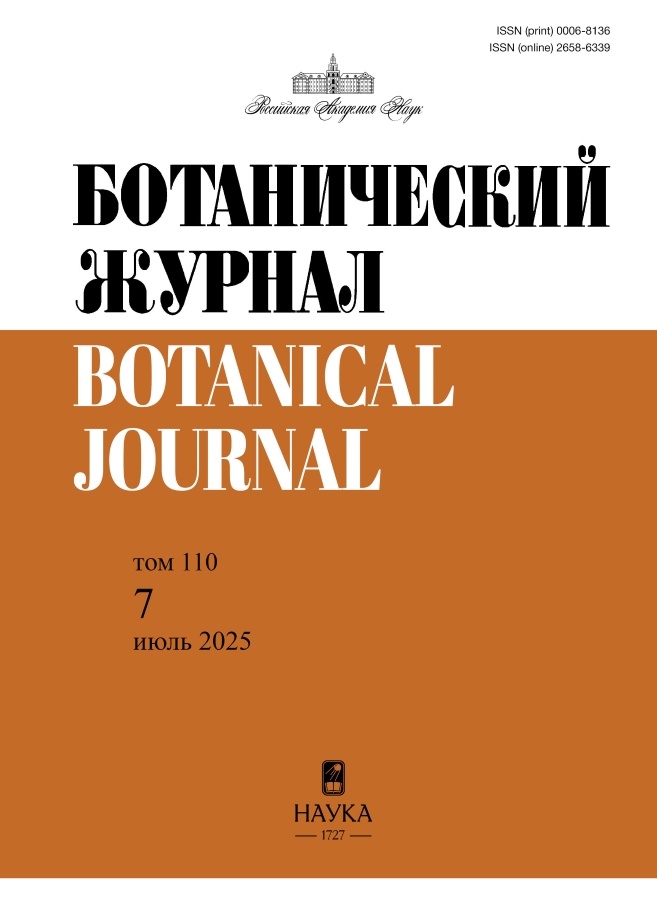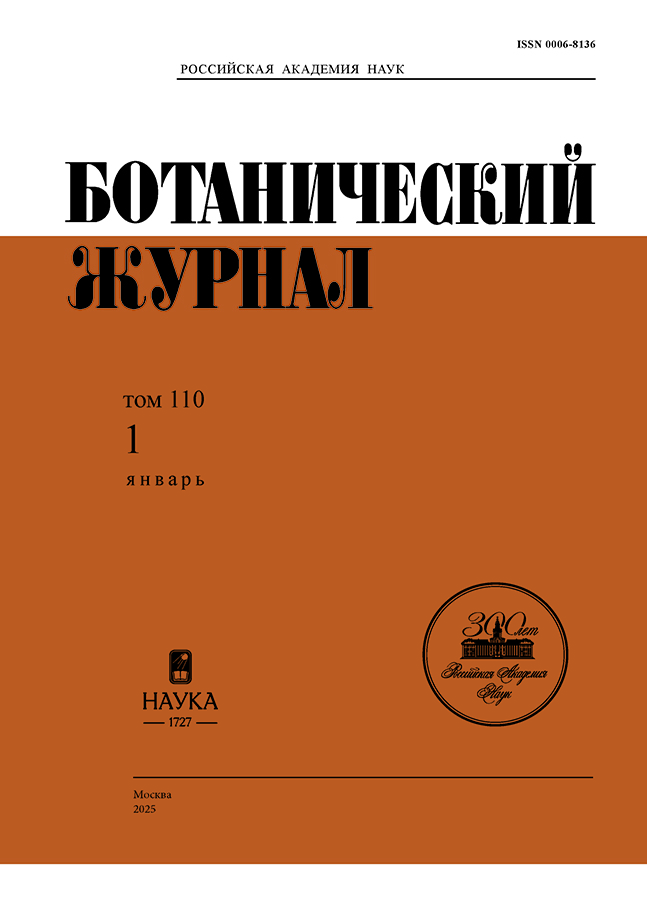Микоризная колонизация водозапасающих клеток коры корней эпифитных орхидных
- Авторы: Бибиков Н.М.1, Воронина Е.Ю.1, Еськов А.К.1, Игнатов М.С.1,2
-
Учреждения:
- Биологический факультет, Московский государственный университет им. М. В. Ломоносова
- Главный ботанический сад РАН им. Н. В. Цицина
- Выпуск: Том 110, № 1 (2025)
- Страницы: 64-70
- Раздел: СООБЩЕНИЯ
- URL: https://rjmseer.com/0006-8136/article/view/682761
- DOI: https://doi.org/10.31857/S0006813625010037
- EDN: https://elibrary.ru/EMPHRF
- ID: 682761
Цитировать
Полный текст
Аннотация
В отличие от наземных орхидных, эпифитные виды обладают водозапасающими элементами, необходимыми для заселения сухих местообитаний. Трахеоидные элементы присутствуют в корнях и участвуют во взаимодействии с микоризными грибами, которые облигатно колонизируют корни орхидных. Лигнифицированные клетки расположены в коре и выполняют роль контроля водообмена. Среди лигнифицированных клеток экзодермы присутствуют тонкостенные пропускные клетки, необходимые для водообмена между корнем и окружающей средой. Данное исследование подтверждает существующие сведения о том, что пропускные клетки являются единственными клетками экзодермы, через которые могут проходить грибные гифы. Также представлены доказательства колонизации водозапасающих клеток микоризными грибами и показано, что лигнифицированные элементы коры менее благоприятны для формирования пелотонов, чем тонкостенные клетки коры.
Ключевые слова
Полный текст
Об авторах
Н. М. Бибиков
Биологический факультет, Московский государственный университет им. М. В. Ломоносова
Автор, ответственный за переписку.
Email: bibik0808@mail.ru
Россия, Москва
Е. Ю. Воронина
Биологический факультет, Московский государственный университет им. М. В. Ломоносова
Email: bibik0808@mail.ru
Россия, Москва
А. К. Еськов
Биологический факультет, Московский государственный университет им. М. В. Ломоносова
Email: bibik0808@mail.ru
Россия, Москва
М. С. Игнатов
Биологический факультет, Московский государственный университет им. М. В. Ломоносова; Главный ботанический сад РАН им. Н. В. Цицина
Email: bibik0808@mail.ru
Россия, Москва; Москва
Список литературы
- Balachandar M., Koshila Ravi R., Ranjithamani A., Muthukumar T. 2019. Comparative vegetative anatomy and mycorrhizal morphology of three South Indian Luisia species (Orchidaceae) with the note on their epiphytic adaptations. — Flora. 251: 39–61. https://doi.org/10.1016/j.flora.2018.12.001
- Brundrett M.C., Enstone D.E., Peterson C.A. 1988. A berberine-aniline blue fluorescent staining procedure for suberin, lignin, and callose in plant tissue. — Protoplasma. 146: 133–142. https://doi.org/10.1007/BF01405922
- Cameron D.D, Johnson I., Read D.J., Leake J.R. 2008. Giving and receiving: Measuring the carbon cost of mycorrhizas in the green orchid, Goodyera repens. — New Phytol. 180: 176–184. https://doi.org/10.1111/j.1469-8137.2008.02533.x
- Chomicki G., Bidel L.P.R., Jay-Allemand C. 2014. Exodermis structure controls fungal invasion in the leafless epiphytic orchid Dendrophylax lindenii (Lindl.) Benth. ex Rolfe. — Flora. 209: 88–94. https://doi.org/10.1016/j.flora.2014.01.001
- Holbein J., Shen D., Andersen T.G. 2021. The endodermal passage cell — just another brick in the wall? — New Phytol. 230: 1321–1328. https://doi.org/10.1111/nph.17182
- Joca T.A., de Oliveira D.C., Zotz G., Cardoso J.C., Moreira A.S. 2020. Chemical composition of cell walls in velamentous roots of epiphytic Orchidaceae. — Protoplasma. 257: 103–118. https://doi.org/10.1007/s00709–019–01421-y
- Kohler A., Kuo A., Nagy L.G., Morin E., Barry K.W., Buscot F., Canbäck B., Choi C., Cichocki N., Clum A. 2015. Convergent losses of decay mechanisms and rapid turnover of symbiosis genes in mycorrhizal mutualists. — Nat. Genet. 47: 410–415. https://doi.org/10.1038/ng.3223
- Koyyappurath S., Conéjéro G., Dijoux J.B., Lapeyre-Montes F., Jade K., Chiroleu F., Gatineau F., Verdeil J.L., Besse P., Grisoni M. 2015. Differential responses of vanilla accessions to root rot and colonization by Fusarium oxysporum f. sp. radicis-vanillae. — Front. Plant. Sci. 18: 1125. https://doi.org/10.3389/fpls.2015.01125
- Li J.W., Zhang S.B. 2019. Physiological responses of orchid pseudobulbs to drought stress are related to their age and plant life form. — Plant. Ecol. 220: 83–96. https://doi.org/10.1007/s11258-018-00904-x
- Miyauchi S., Kiss E., Kuo A., Drula E., Kohler A., Sánchez-García M., Morin E., Andreopoulos B., Barry K.W., Bonito G. 2020. Large-scale genome sequencing of mycorrhizal fungi provides insights into the early evolution of symbiotic traits. — Nat. Commun. 11: 1–17. https://doi.org/10.1038/s41467-020-18795-w
- Olatunji O.A., Nengim R.O. 1980. Occurrence and distribution of tracheoidal elements in the Orchidaceae. — Bot. J. Linn. Soc. 80: 357–370. https://doi.org/10.1111/j.1095-8339.1980.tb01669.x
- Petrolli R., Augusto Vieira C., Jakalski M., Bocayuva M.F., Vallé C., Cruz E.D.S., Selosse M.A., Martos F., Kasuya M.C.M. 2021. A fine-scale spatial analysis of fungal communities on tropical tree bark unveils the epiphytic rhizosphere in orchids. — New Phytol. 231: 2002–2014. https://doi.org/10.1111/nph.17459
- Porembski S., Barthlott W. 1988. Velamen radicum micromorphology and classification of Orchidaceae. — Nord. J. Bot. 8: 117–137. https://doi.org/10.1111/j.1756-1051.1988.tb00491.x
- Pujasatria G.C., Nishiguchi I., Miura C., Yamato M., Kaminaka H. 2022. Orchid mycorrhizal fungi and ascomycetous fungi in epiphytic Vanda falcata roots occupy different niches during growth and development. — Mycorrhiza. 32: 481–495. https://doi.org/10.1007/s00572-022-01089-y
- Ramesh G., Ramudu J., Khasim S.M., Thammasiri K. 2020. Structural adaptations of Bulbophyllum and Dendrobium (Orchidaceae) to the epiphytic habitat and their phylogenetic implications. — In: Orchid Biology: Recent Trends & Challenges. Springer, Singapore. P. 303–342. https://doi.org/10.1007/978-981-32-9456-1
- Tay J.Y., Zotz G., Gorb S.N., Einzmann H.J. 2021. Getting a grip on the adhesion mechanism of epiphytic orchids-evidence from histology and cryo-scanning electron microscopy. — Front. For Glob. Change. 4: 764357. https://doi.org/10.3389/ffgc.2021.764357
- Xing X., Jacquemyn H., Gai X., Gao Y., Liu Q., Zhao Z., Guo S. 2019. The impact of life form on the architecture of orchid mycorrhizal networks in tropical forest. — Oikos. 128: 1254. https://doi.org/10.1111/oik.06363
Дополнительные файлы















